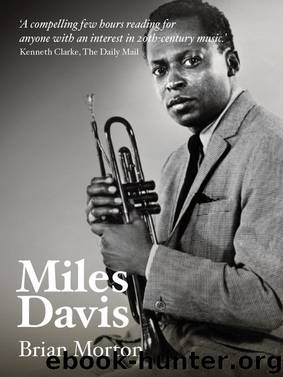Miles Davis by Brian Morton

Author:Brian Morton [Brian Morton]
Format: epub
ISBN: 9781908446060
Publisher: HopeRoad Publishing, Ltd.
Published: 2012-11-16T16:00:00+00:00
Directions in Music
The mournful woman in the trumpeter’s shadow on the cover of Friday/Saturday at the Blackhawk is Frances Taylor Davis. At a time when most record labels insisted on putting pretty white girls on the cover of jazz records, cheesecake images that often jarred with the musical content, Miles had “started demanding that Columbia use black women on my album covers”. Frances had already appeared on the front of Some Day My Prince Will Come, which included the theme “Pfrancing” inspired by her. She figured again (with Miles) on E.S.P. but within days of being photographed for that record she walked out, ending a passionate but stormy (and ultimately violent) relationship and breaking up the seemingly happy family home in that converted Russian Orthodox church on West 77th Street.
Over the next two and a half years, the course of Miles’s romantic life could be traced by his cover art. His relationship with the beautiful actress Cicely Tyson resulted in her appearance on the cover of Sorcerer in 1967; their affair resumed some years later and she became Miles’s third wife, only divorcing him two years before his death. After Miles’s divorce from Frances was finalised in February 1968, he fell in love with singer Betty Mabry, the “Mademoiselle Mabry” celebrated on his next album Filles de Kilimanjaro and on whose cover she appears. They were married later that year, and separated twelve months later, apparently because Betty – who continued to use her married surname for the rest of her career, despite its similarity to Bette Davis – had an affair with rock guitarist Jimi Hendrix. A subsequent relationship with Marguerite Eskridge, who was riding in Miles’s Ferrari at the time of the shooting incident, led to her appearance on the cover of At the Fillmore. They had a son together, Erin, his fourth and last child.
Despite the addition to his family, people were leaving Miles. In the later 60s, his love life was more turbulent than at any time since his romance with Juliette Greco. Trusted musicians had used the cachet of playing in his band to promote their solo careers. He had a further violent falling-out with drummer Max Roach. His mother and father had passed on, and in July 1967 John Coltrane succumbed to liver cancer, having continued to work right to the end.
Miles’s reaction to his old colleague’s passing was characteristically terse and pungent, but also more than personal: “it f***ed up everyone…. His death created chaos in the ‘free thing’ because he was its leader. He was like Bird to all those musicians who considered themselves ‘out’ – you know, ‘free’, out in space: he was like a god to them”. How literally that last phrase might be taken can be gauged from the existence in San Francisco of the Saint John Coltrane African Orthodox Church, a tiny storefront communion which regards Trane’s extended improvisations as actual routes to spiritual transcendence. His immediate musical legacy, fragmented and problematic, was also given a strong religious
Download
This site does not store any files on its server. We only index and link to content provided by other sites. Please contact the content providers to delete copyright contents if any and email us, we'll remove relevant links or contents immediately.
Aircraft Design of WWII: A Sketchbook by Lockheed Aircraft Corporation(32192)
The Great Music City by Andrea Baker(31251)
Call Me by Your Name by André Aciman(20351)
The Secret History by Donna Tartt(18811)
The Art of Boudoir Photography: How to Create Stunning Photographs of Women by Christa Meola(18504)
Shoot Sexy by Ryan Armbrust(17637)
Plagued by Fire by Paul Hendrickson(17314)
Portrait Mastery in Black & White: Learn the Signature Style of a Legendary Photographer by Tim Kelly(16933)
Adobe Camera Raw For Digital Photographers Only by Rob Sheppard(16882)
Photographically Speaking: A Deeper Look at Creating Stronger Images (Eva Spring's Library) by David duChemin(16601)
Ready Player One by Cline Ernest(14496)
Pimp by Iceberg Slim(14323)
Bombshells: Glamour Girls of a Lifetime by Sullivan Steve(13953)
The Goal (Off-Campus #4) by Elle Kennedy(13477)
Art Nude Photography Explained: How to Photograph and Understand Great Art Nude Images by Simon Walden(12954)
Kathy Andrews Collection by Kathy Andrews(11709)
The Priory of the Orange Tree by Samantha Shannon(8862)
The remains of the day by Kazuo Ishiguro(8791)
Thirteen Reasons Why by Jay Asher(8767)
